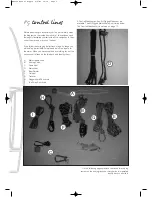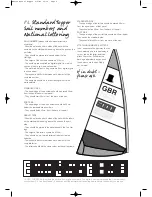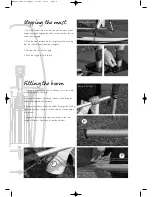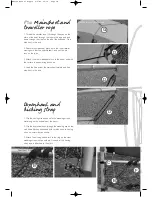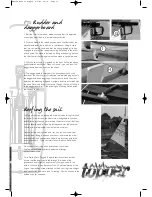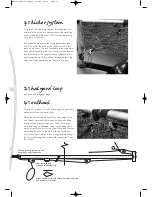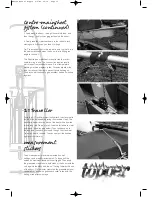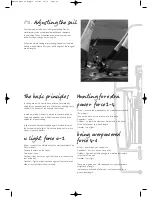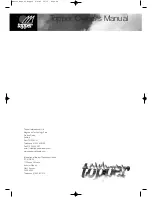
P19.
maintenance
Very little maintenance is required to your Topper, but some
care and attention will produce better sailing performance.
Hull and deck
The polypropylene from which the hull and deck are
moulded is very strong but can be scratched so avoid
pulling the boat over shingle or scraping it on anything
hard and always try to rig the boat on a reasonably soft
surface.
The moulding material has special additives to provide
resistance to the effects of ultra-violet light, but very
prolonged exposure to strong sunlight may affect the
surface over the period of a number of years. Therefore
it is recommended that you cover the boat or store it in the
shade.
Static electricity on a polypropylene surface attracts dust.
The harder you rub it with a duster the more dust will stick.
So it is best to wash it or try an anti-static polish.
An annual check of screw tightness is a good discipline, but
be careful not to overtighten.
Mast Cup
Clean out the grit and sand. The base of the cup can may
get worn from the repeated movement of the mast heel. If
the cup becomes worn, remove the central screw holding
the cup in position and fit a replacement cup and disc. Do
not tamper with the bolt beneath the cup.
Self bailer
Keep clean and wash out grit. Ensure screws are tight but
be careful not to overtighten.
Drainplug
It is recommended that this is removed at night and for
winter storage.
Rudder
The rudder blade is intended to stay down in the fully lowered
position when the tiller is lowered onto the pillar of the
rudder stock (aluminium casting). If the rudder blade hits a
submerged object hard, the blade will force the tiller to slide
up on the pillar to allow it to move forward, thus releasing a
locking mechanism and letting the rudder blade come up.
In order to do this correctly - yet not allow the blade to
come up during normal sailing - the friction at the joint
between the tiller and rudder must be adjusted correctly.
This is done by adjusting the spring nut on the tiller pivot
bolt. You must get this right by trial and error. It is also
important that the bearing surfaces between the locking
pegs on the tiller and the notches on the rudder stock pillar
are smooth and clean, otherwise the tiller will not slide
upwards when the rudder blade hits an obstacle.
Tiller extension
No maintenance is required but check that the universal
linkage is secure.
Rudder Pintle on Hull
This is the stainless steel transom plate on which the rudder
pivots. Check occasionally that the fixing screws are secure
and that there is not undue wear on the pivot pin.
Mastgate
Keep washed out and free from grit and sand. Do not
lubricate.
Top mast
This is designed to be water tight. The upper end fitting
is sealed in with mastic and the lower end is plugged. It
is difficult to check the top mast for leakage and the only
practical way is by prolonged immersion.
Lower mast and boom
Check screws and rivets on fittings regularly.
Sail
The sail is very strong and will not rot, but can be spoiled
by unsympathetic use. Occasionally wash any salt off the
sail with fresh water with a hose, do not use a washing
machine. Dry and fold carefully. Roll up the folded sail
and stow it in its bag. If you crumple up the sail or stuff it in
the bag unfolded you are liable to breakdown the smooth
surface of the cloth and affect the performance of the sail.
It will not ruin it but it will become less efficient.
Blocks
Wash these occasionally and keep them free from grit. Do
not lubricate.
Ropes
Check these occasionally for chafe and wear and tear.
Storage
The Topper may be stood on its transom, providing pintle
and gudgeon are kept clear of the ground. It can be slung
in straps or stored upside down in the same way that it is
supported on a roof rack. If the hull is put in a rack the right
way up, it is important to ensure that the forward support
lies directly under the mast step, and that the load is spread
as much as possible.
Owners manual Topper 8/2/06 12:35 Page 19

